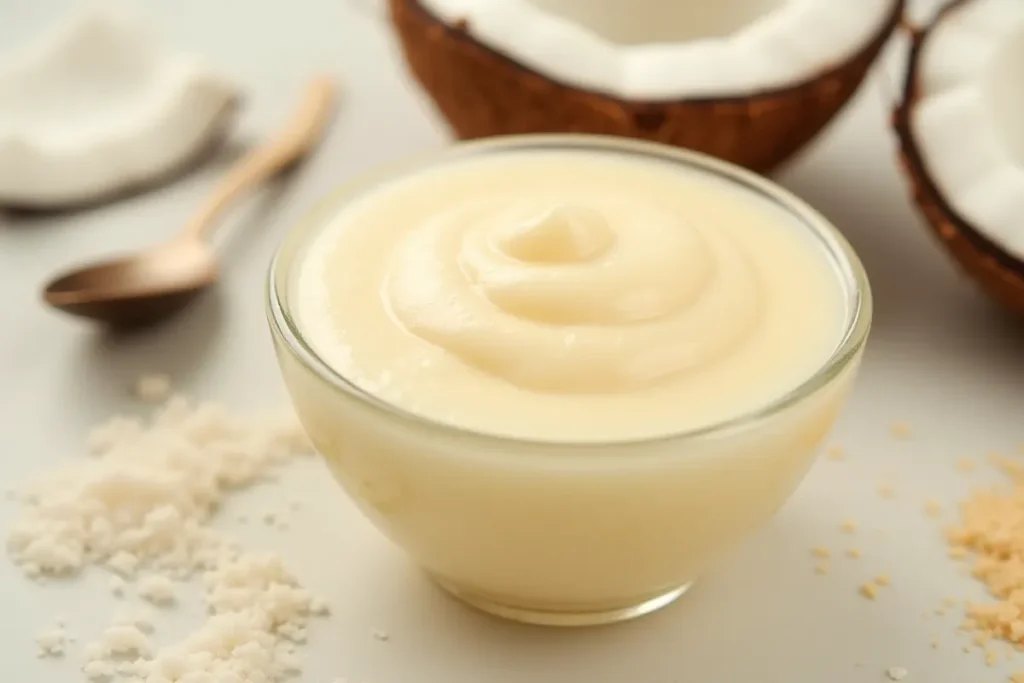Coconut-based products are more popular than ever. Today, coconut syrup stands out as a versatile option among natural sweeteners. As people search for healthier alternatives to refined sugar, this tropical treat continues to gain recognition. Consequently, it’s essential to learn about its properties, benefits, and different ways to use it. In this guide, you’ll discover everything you need to know, from nutritional highlights to exciting recipes. By the end, you’ll feel confident about making informed decisions when incorporating it into your meals.
What Is Coconut Syrup?
This product is a sweet, pourable liquid that typically comes from the sap of coconut palm trees. Manufacturers boil or evaporate the raw liquid until it reaches a syrupy consistency. During this process, the natural sugars concentrate, resulting in a delicious sweetener with a subtle caramel-like flavor.
Key characteristics
- Golden to dark brown in color
- Thick yet still pourable
- Distinctive taste that often hints at caramel or butterscotch
It’s important not to confuse this syrup with other coconut-derived items like coconut milk or coconut oil. Those come from the coconut’s meat, whereas the liquid sweetener is derived from sap or nectar found in the flower buds of the coconut palm. People appreciate this sweetener because it usually undergoes minimal processing and may retain trace minerals absent in refined sugars.
Historical background
In tropical regions, locals have harvested coconut palm sap for centuries, using it in various sweet products. Modern-day commercial versions benefit from improved processing methods. Hence, consumers worldwide can enjoy its unique taste and potential benefits, such as a moderate glycemic index. Still, keep in mind that it remains a sugar source and should be consumed wisely.
A Brief History of This Sweetener
For generations, coastal communities in Asia relied heavily on the coconut palm, referred to by some as the “tree of life.” They discovered that its sap—sometimes called “toddy” or “tuba”—could be turned into a sweet, thick liquid when heated. This early method paved the way for the product we know today.
Spread through trade
Seafaring merchants introduced this type of nectar to different areas, popularizing it in regional cuisines. Southeast Asian countries began using it in a range of desserts, while other cultures adapted the sweetener for local dishes. With globalization, the sweet liquid made its way into health food stores, supermarkets, and online shops, reaching consumers worldwide.
Modern popularity
Interest has grown thanks to the rise of holistic lifestyles and clean-eating movements. Since it undergoes fewer processing steps than many refined sugars, it can retain more natural qualities. Nonetheless, it does contain sugars, so restraint is crucial for optimal health.

Nutritional Highlights
Although each brand may vary slightly, this palm-based sweetener generally contains a mix of fructose, glucose, and sucrose. It also offers:
- Trace minerals: Potassium, magnesium, zinc
- Vitamins: Small amounts of vitamin C
- Potential antioxidants
- Moderate glycemic index (commonly in the 35–54 range)
By comparison, standard table sugar has a glycemic index around 65. However, this doesn’t mean you can indulge limitlessly. Overeating any sugar source can elevate blood glucose, making moderation key.
Understanding the vitamins and minerals
While it’s often seen as healthier than refined sugar, keep expectations realistic. The syrup’s mineral content is modest. It may provide slight nutritional value, but it won’t replace nutrient-dense foods like fruits or vegetables. Consider it an occasional upgrade if you’re looking for a natural sweetener that isn’t as heavily refined as white sugar.
Health Benefits and Potential Advantages
Because it’s less refined, this sweetener tends to keep some natural properties from the sap. As a result, many health enthusiasts view it as a step above typical sugar.
- Moderate glycemic index
It typically ranks lower than refined sugar. Therefore, it may cause smaller spikes in blood sugar. - Trace minerals
Though modest, minerals like potassium, magnesium, and zinc may offer minor nutritional perks. - Possible antioxidants
Some research indicates that coconut palm products contain antioxidant compounds. - Easy to use
It seamlessly fits into various cuisines and cooking methods, making it a flexible choice for sweetening beverages, glazes, and desserts.
How does it differ from refined sugar?
Conventional white sugar is stripped of almost all nutrients during processing. By contrast, this sap-based syrup often retains some minerals and vitamins. Nevertheless, both are still sugar. If you have specific health needs, be sure to discuss them with a healthcare professional before making major dietary changes.

Everyday Uses in the Kitchen
One standout feature of this sweetener is its adaptability. You can drizzle it, bake with it, or stir it into sauces and marinades. It imparts a subtle caramel undertone, which can enhance both sweet and savory recipes.
Popular ways to incorporate it
- Drizzling: Pour over pancakes, waffles, or oatmeal.
- Baking: Use in muffins, cakes, and cookies. Adjust other liquids or oven temperature as needed.
- Beverages: Sweeten coffee, tea, smoothies, or lemonade.
- Marinades and sauces: Add to barbecue sauce or teriyaki marinade for a tropical flair.
Recipe adjustments
Because it’s liquid, reduce other liquids in your recipe accordingly. Also, note that this syrup browns quickly, so keep an eye on baked goods.
Baking tips
- Lower your oven temperature by about 25°F (15°C) to prevent over-browning.
- Decrease other liquids in the recipe slightly to maintain consistency.
- Combine with baking soda if you need to balance acidity for proper rising.
Master these simple tricks to integrate the syrup into various recipes without overpowering flavors.
Comparing It to Other Sweeteners
You’re likely familiar with honey, maple syrup, and agave nectar. Each sweetener has its unique flavor profile and nutritional attributes. So how does this palm-based nectar stack up?
Honey
- Contains enzymes and antioxidants.
- Floral taste profile.
- Often higher on the glycemic index.
Maple syrup
- Comes from maple tree sap.
- Offers an earthy sweetness and minerals like manganese.
- Ranges similarly on the glycemic scale.
Agave nectar
- Extracted from the agave plant.
- Can have very high fructose content, which some people prefer to limit.
- Often advertised for its low GI, though fructose metabolism can still pose issues.
Which one is best?
Your choice depends on flavor preferences, nutritional goals, and dietary restrictions. If you love a caramel-like undertone, the coconut-based syrup might be your top pick. Maple syrup brings a different earthy note, while honey offers floral sweetness. Regardless of the sweetener you select, moderation is essential due to their sugar content.
Selecting and Storing High-Quality Products
Not all brands are equal. Processing methods, packaging, and ingredient additives can influence overall taste and nutritional value. To get the best quality, keep the following tips in mind:
- Check the ingredient list
Opt for products with minimal or no additives. Pure sap or nectar is ideal. - Examine color and consistency
The liquid may range from golden to dark brown, with a thicker texture generally indicating a richer flavor. - Choose reputable suppliers
Some brands have transparent sourcing and production methods. Reading reviews can also guide you to quality options. - Store properly
Keep the opened bottle in a cool, dry spot. Refrigeration helps prolong freshness. If crystallization occurs, gently warm the container in warm water to restore the syrupy texture.
Shelf life
Most commercial products last several months to a year. Always check the expiration date and discard if you notice an unusual smell or flavor.
Potential Drawbacks
Despite its appeal, this sweetener isn’t without drawbacks. Like all sugars, it should be consumed with care.
- High sugar content
Even though it may have a lower GI, it’s still a concentrated source of carbohydrates. - Allergy concerns
Though rare, some individuals might react to coconut-derived products. - Varying quality
Some brands mix in other sugars or thickeners. Always read labels to confirm product purity.
Avoiding misleading claims
Marketing language can sometimes exaggerate the health benefits of natural products. While it’s less refined than table sugar, it’s still an added sugar. Balance is key—check labels, consult health professionals if needed, and be mindful of daily sugar limits.
Recipe Inspiration
Ready to explore? Here are some fun ways to use this nectar in home cooking.
- Tropical Pancakes
- Combine whole wheat flour, baking powder, and salt.
- Mix in mashed banana and non-dairy milk.
- Cook on a hot griddle, then top with the syrup.
- Tip: Add shredded coconut for extra flair.
- Granola
- Toss oats, chopped nuts, seeds, and salt together.
- Drizzle with the coconut-based syrup and coconut oil.
- Bake at 325°F (160°C) until golden, stirring occasionally.
- Tip: Monitor closely, as it can brown quickly.
- Sweet-and-Spicy Marinade
- Combine soy sauce, minced ginger, garlic, and a dash of lime juice.
- Stir in a spoonful of the syrup for a sweet contrast.
- Marinate chicken, tofu, or shrimp before grilling.
- Banana Bread
- Swap out white sugar in your favorite recipe, using this nectar instead.
- Add ripe mashed bananas, eggs, flour, and baking soda.
- Bake at 350°F (175°C) for roughly 45-55 minutes.
- Tip: The caramel nuance pairs perfectly with banana.
- Dipping Sauce
- Combine the syrup with chili flakes, lime juice, and fish sauce (optional).
- Use as a dipping sauce for spring rolls or grilled skewers.
Common Misconceptions
- Myth: It’s sugar-free.
- Reality: It contains natural sugars, which can raise blood glucose levels.
- Myth: It can cure diseases.
- Reality: While it has trace nutrients, it isn’t a medical remedy.
- Myth: It tastes purely like coconut.
- Reality: Its flavor leans more toward caramel, unlike coconut milk or shredded coconut.
- Myth: All products labeled “coconut” are healthy.
- Reality: Some brands include additives. Always check the fine print.
Frequently Asked Questions
What is a coconut syrup?
It’s a sweetener made from the sap or nectar of coconut palm trees. Producers collect the sap from flower buds and boil or evaporate it until it thickens into a syrupy liquid. The end result often features a caramel-like flavor and a golden-to-dark-brown color.
Is this sweetener good or bad for you?
It can be an upgrade from heavily processed sugars due to minimal refining and trace minerals. However, it still contains sugar, so moderation remains essential. When used in controlled amounts, it can fit into a balanced diet.
Is it better than honey?
It depends on your personal needs and preferences. Honey offers enzymes and antioxidants, while this palm-based syrup tends to have a moderate GI rating. Some people prefer the caramel undertones of the coconut product, whereas others favor the floral notes of honey. Both are still sugars, so use them sparingly.
Is it okay for diabetics?
Although some find it less disruptive to blood sugar than table sugar, it isn’t sugar-free. Diabetics should consult a medical professional before making any substitutions. Carbohydrate tracking and blood sugar monitoring are crucial to managing diabetes.
Conclusion
This palm-based sweetener can serve as a flavorful alternative to heavily processed sugars. Its moderate glycemic index, subtle caramel flavor, and trace nutrients attract many health-conscious consumers. Whether drizzled over pancakes, blended into sauces, or used in baked goods, it can elevate everyday meals.
Remember, coconut syrup still sugar. Approach it thoughtfully by reading ingredient labels and consuming moderate amounts. With careful use, you can enjoy its unique benefits without derailing your nutrition goals. Don’t be afraid to experiment in the kitchen—its versatility and depth of flavor might inspire new culinary creations!

